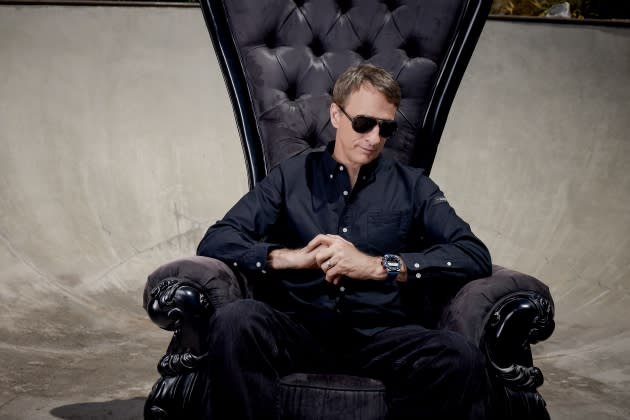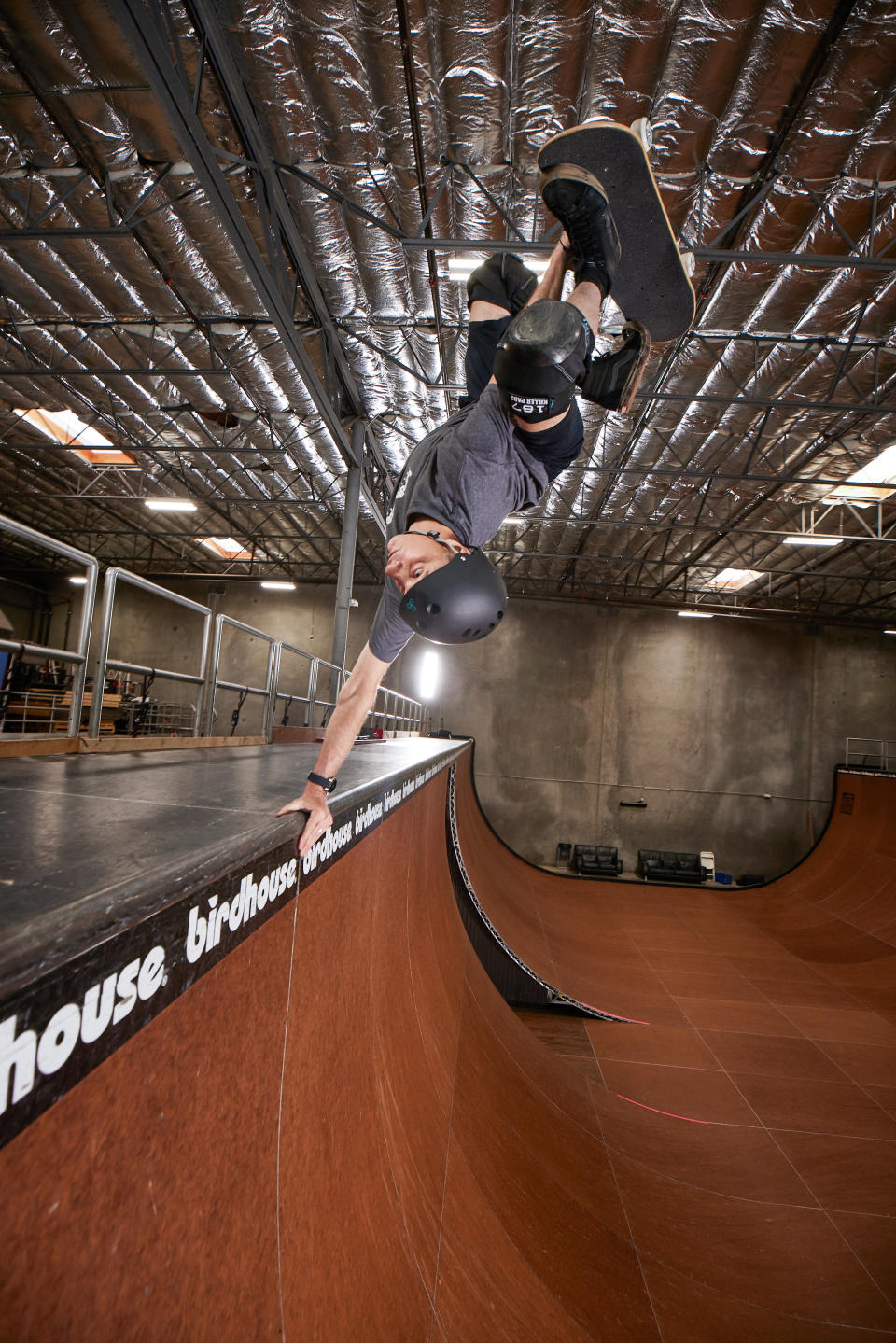How Is Tony Hawk Gaining His Confidence Back Post-Injury? With NASA-Backed Tech On His Wrist
- Oops!Something went wrong.Please try again later.

If you purchase an independently reviewed product or service through a link on our website, Rolling Stone may receive an affiliate commission.
Tony Hawk is a legendary skateboarder, watch collector, and self-professed gadget geek — he’d just never worn a wearable for fitness before. That is, until he broke his femur misjudging the landing on a McTwist back in 2022.
More from Rolling Stone
'Style for Decades': Fashion Icons Diane Keaton and Michelle Yeoh Star in J.Crew's New Campaign
Easy Relief: 6 Affordable Massage Guns That Punch Above Their Price Point
“I was too cavalier in my initial approach to healing,” Hawk said in an interview with Rolling Stone. Shortly following the initial injury, Hawk had tried to jump back into skating again, but it had ended up being too soon. He revealed in an Instagram post last November that he had ignored “all warning signs — pain, mostly — and ended up shifting the bone placement that never allowed it to fuse properly.” In a way, he was grateful for a “do-over” of sorts, hoping that having more patience and less expectations of himself would lead to a fuller recovery.
This time around, his approach was much improved, not only thanks his mindset shift, but to one specific tool — his Citizen CZ Smart Watch. “It’s been helping me to track the optimal time to be active during the day, my sleep, and obviously, my heart rate,” Hawk said. “It’s been super helpful to figure out when I should be trying to get out there and really be active in a way that I consider a professional level.”

Citizen CZ Smart Watch
So what makes this latest Citizen watch so smart? Unveiled at CES 2023, their CZ Smart Gen-2 collection features a new, built-in YouQ app, which was built with the one-two punch of research pioneered by the NASA Ames Research Center, and AI Models built with IBM Watson Studio. It first determines your Chronotype (a hereditary trait that determines your preferred timing of sleep and wake), then forecasts your level of cognitive and physical energy 24-hours ahead with an hourly “Power Score”. This way you can anticipate when you should hit the gym (or the half-pipe, in Hawk’s case), and when you should take it easy.
Hawk says it’s also helped optimize his performance through the watches personalized insights, dubbed “Power Fixes”. Tailored to you, it can suggest ways to extend peaks or curb drops in alertness, like by taking a nap or eating a high-protein snack. Consider it a wearable self-care advisor, like putting a piece of NASA on your wrist.
We sat down with Hawk to chat about how the CZ Smart Watch has helped his personal recovery process, celebrating the small wins, and seeing skating as the great equalizer.
You’re about a year out from a pretty debilitating leg injury — how does the CZ Smart Watch and Smart YouQ help you help you make smarter choices for your recovery?
I was too cavalier in my initial approach to healing. And then this time around, I just had a much better approach to it, thanks to my Citizen Smart Watch. It’s been helping me to track the optimal time to be active during the day, my sleep, and obviously, my heart rate. I’ve never worn anything like that before, no wearable that’s really tracking my body rhythms. It’s been super helpful to figure out when I should be trying to get out there and really be active in a way that I consider a professional level.
Obviously, this is introducing more data into the recovery process than you would normally get just from getting PT exercises from your doctor. How has that been helpful or interesting, using a watch for recovery like that?
Yeah, it’s fascinating. Like I said, I’ve never known so much about my body, or when I’m most alert. In terms of using it, it’s been enlightening. I’m always checking all the stats, making sure it’s good. You know, I’m only four and a half months into my last surgery, and I’m going to skate the X Games in a few weeks. If you had told me even six months ago that I would be doing that, I’d say no way.
Besides sleep or activity, what’s been the most surprising thing that you’ve learned about your life routine, or your body, that you didn’t know before using the smart watch?
My [lower] heart rate, even when I’m skating as hard as I can. These days especially, I feel like I’ve got to really make a greater effort to get out there and skate at that level. But if I looked at all the data, you wouldn’t know when I skated through the day. So that was surprising to me. I guess it’s kind of a flex, like, it’s cool that I feel that calm. But it was surprising to learn that through my Citizen watch.
Maybe that’s been the secret all these years.
[Laughs] That’s my Zen. My meditation.
Are there any other new kinds of technologies you’d see gaining traction in the future in terms of skating? Because it’s pretty technology-lacking compared to other sports.
Yeah, I think that something — especially if it’s more in tune with skating motions — that would be helpful to see would be, what are the true calories? What are we burning when we’re doing that? Because as of yet, there isn’t much giving specifics. It’s tracking general movement. I can sort of translate how many steps I’ve been taking through the depths of what that means in terms of skating. But I think that, if you’re talking about future technologies for skating, that would be fascinating to me.
So you know you tried to skate a little too soon after breaking your leg. I was wondering, besides taking your time after you get an injury, what other kind of advice would you give to someone in recovery?
I would say celebrate the small wins. Because I think that’s a huge part of what I do — and I have to reach these big milestones. I’ve learned to be a little more realistic with my goals. Even if I leave the ramp, or if I’m done skating for the day, and I don’t accomplish some great goal, I do think, ‘well, what was the progress there?’. And I’m much more into celebrating that, as opposed to before, when I didn’t accomplish my main goal. I track that through weeks and months with the watch. Now, if I’m looking at footage of me from two weeks ago, I can tell that I’m much better than before. Maybe you wouldn’t be able to tell that, but I can tell. And I embrace that.
I’ve had several sports injuries too, and I always feel like the most difficult thing is the mental impact when you’re trying to get back into it. Can you talk about how you tackled the mental side of getting back into skating?
That’s probably been the biggest challenge, getting my confidence back. Because there are things that I used to do and take for granted, not even considering them difficult, that nowadays are a big hurdle. Something that I have to convince myself that I once did with ease. So that probably is equally as challenging as the physical limitations that I’m facing. It’s no joke. I mean, there’s things that I’m not entirely sure of, things I could just convince myself are going to be okay.
In your post-competitive career, you’ve talked about bringing skating to more communities and building skate parks, like with the Navajo Nation park recently. What do you think it is about skating that makes a kind of an equalizer, something that can bring joy to everyone?
Well, I think it’s for one, low cost of entry. You can just skateboard and you’re in, and that doesn’t require membership fees. You don’t have to join a team — you probably wouldn’t be joining a team. And you can have a sense of community, even though it’s an individual pursuit. I think that if you were to drive by a skate park right now, there are people of all ages, of all backgrounds, of all genders, enjoying their time together and encouraging each other. And I don’t know of any other sports like that.
Best of Rolling Stone
Click here to see more up-to-date holiday deals!

